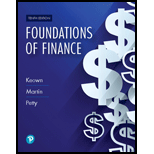
- a. What is meant by the investor’s required
rate of return ? - b. How do we measure the riskiness of an asset?
- c. How should the proposed measurement of risk be interpreted?
1.
To discuss: The meaning of investor’s required rate of return.
Explanation of Solution
The meaning of investor’s required rate of return is as follows:
The required rate of return is the return of an investor which is important to invite an investor to buy or hold a security.
2.
To discuss: The ways to measure the riskiness of an asset.
Explanation of Solution
The ways to measure the riskiness of an asset is as follows:
Risk is the potential fluctuation in returns on an investment. Therefore, the higher the vulnerability or uncertainty with regards to the specific result, the higher is the risk. The risk might be estimated as far as the standard deviation of rate of return or by the variances of rates of return, which are just the squared values of the standard deviation.
3.
To discuss: The ways proposed measurement of risk is interpreted.
Explanation of Solution
The ways proposed measurement of risk is interpreted is as follows:
Higher standard deviation of returns demonstrates higher risk related with the investment. The future cash flows have a higher potential variation. Though, regardless of whether the standard deviation is huge comparative with the returns must be inspected as for other investment opportunities. On the other hand, the probability analysis is an important methodology to deal with catch higher comprehension of the vastness of a standard deviation figure.
Want to see more full solutions like this?
Chapter 6 Solutions
Foundations Of Finance
- A bond pays a 6% annual coupon and is priced at a discount. What does this indicate? A) Yield to maturity < coupon rateB) Yield to maturity = coupon rateC) Yield to maturity > coupon rateD) Bond is at par need correct answer and explarrow_forwardWhich of the following best describes standard deviation in finance? A) A measure of liquidityB) A measure of returnC) A measure of volatilityD) A measure of leveragei need helparrow_forwardWhich of the following best describes standard deviation in finance? A) A measure of liquidityB) A measure of returnC) A measure of volatilityD) A measure of leverageneed helparrow_forward
- Which of the following best describes standard deviation in finance? A) A measure of liquidityB) A measure of returnC) A measure of volatilityD) A measure of leveragearrow_forwardA bond pays a 6% annual coupon and is priced at a discount. What does this indicate? A) Yield to maturity < coupon rateB) Yield to maturity = coupon rateC) Yield to maturity > coupon rateD) Bond is at par i needarrow_forwardA bond pays a 6% annual coupon and is priced at a discount. What does this indicate? A) Yield to maturity < coupon rateB) Yield to maturity = coupon rateC) Yield to maturity > coupon rateD) Bond is at par need helparrow_forward
- In CAPM, the risk-free rate increases. What happens to the expected return? A) IncreasesB) DecreasesC) Remains the sameD) Becomes negativearrow_forwardNo Chatgpt! What is the future value of $1,000 invested for 3 years at an annual interest rate of 5% compounded annually?arrow_forwardA bond pays a 6% annual coupon and is priced at a discount. What does this indicate? A) Yield to maturity < coupon rateB) Yield to maturity = coupon rateC) Yield to maturity > coupon rateD) Bond is at pararrow_forward
- I need correct answer In CAPM, the risk-free rate increases. What happens to the expected return? A) IncreasesB) DecreasesC) Remains the sameD) Becomes negativearrow_forwardIn CAPM, the risk-free rate increases. What happens to the expected return? A) IncreasesB) DecreasesC) Remains the sameD) Becomes negative helparrow_forwardWhat is the future value of $1,000 invested for 3 years at an annual interest rate of 5% compounded annually?need coarrow_forward
 EBK CONTEMPORARY FINANCIAL MANAGEMENTFinanceISBN:9781337514835Author:MOYERPublisher:CENGAGE LEARNING - CONSIGNMENT
EBK CONTEMPORARY FINANCIAL MANAGEMENTFinanceISBN:9781337514835Author:MOYERPublisher:CENGAGE LEARNING - CONSIGNMENT Pfin (with Mindtap, 1 Term Printed Access Card) (...FinanceISBN:9780357033609Author:Randall Billingsley, Lawrence J. Gitman, Michael D. JoehnkPublisher:Cengage Learning
Pfin (with Mindtap, 1 Term Printed Access Card) (...FinanceISBN:9780357033609Author:Randall Billingsley, Lawrence J. Gitman, Michael D. JoehnkPublisher:Cengage Learning Intermediate Financial Management (MindTap Course...FinanceISBN:9781337395083Author:Eugene F. Brigham, Phillip R. DavesPublisher:Cengage Learning
Intermediate Financial Management (MindTap Course...FinanceISBN:9781337395083Author:Eugene F. Brigham, Phillip R. DavesPublisher:Cengage Learning Financial Reporting, Financial Statement Analysis...FinanceISBN:9781285190907Author:James M. Wahlen, Stephen P. Baginski, Mark BradshawPublisher:Cengage LearningPrinciples of Accounting Volume 2AccountingISBN:9781947172609Author:OpenStaxPublisher:OpenStax College
Financial Reporting, Financial Statement Analysis...FinanceISBN:9781285190907Author:James M. Wahlen, Stephen P. Baginski, Mark BradshawPublisher:Cengage LearningPrinciples of Accounting Volume 2AccountingISBN:9781947172609Author:OpenStaxPublisher:OpenStax College




